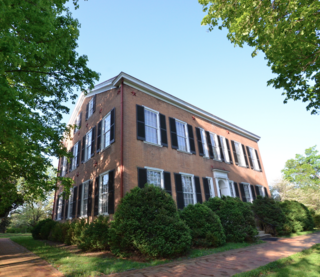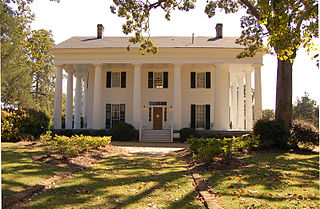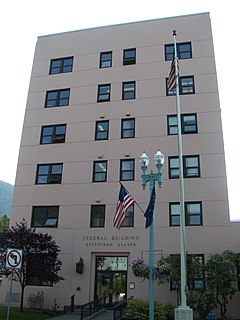
Georgetown is a historic neighborhood and a commercial and entertainment district located in northwest Washington, D.C., situated along the Potomac River. Founded in 1751 in the Province of Maryland, the port of Georgetown predated the establishment of the federal district and the City of Washington by 40 years. Georgetown remained a separate municipality until 1871, when the United States Congress created a new consolidated government for the whole District of Columbia. A separate act passed in 1895 specifically repealed Georgetown's remaining local ordinances and renamed Georgetown's streets to conform with those in the City of Washington.

My Old Kentucky Home State Park is a state park located in Bardstown, Kentucky. The park's centerpiece is Federal Hill, a farm owned by United States Senator John Rowan in 1795. During the Rowan family's occupation, the mansion became a meeting place for local politicians and hosted several visiting dignitaries. The farm is best known for its association with American composer Stephen Foster's anti-slavery ballad "My Old Kentucky Home, Good Night". Foster was a cousin of the Rowan family, and was likely inspired to write the ballad both by Harriet Beecher Stowe's anti-slavery novel Uncle Tom's Cabin and through imagery seen on visits to Federal Hill. After popularity of the song increased throughout the United States, Federal Hill was purchased by the Commonwealth of Kentucky, dedicated as a historic site, and renamed "My Old Kentucky Home" on July 4, 1923. Foster's song by the same name was made the state song of Kentucky in 1928. The Federal Hill mansion was featured on a U.S. postage stamp in 1992, and it is one of the symbols featured on the reverse of the Kentucky state quarter issued in 2001.

The Zachary Taylor House, also known as Springfield, was the boyhood home of the twelfth President of the United States, Zachary Taylor. Located in Louisville, Kentucky, Taylor lived there from 1795 to 1808, held his marriage there in 1810, and returned there periodically the rest of his life.

The Cornelius Wynkoop Stone House is located along US 209 in the hamlet of Stone Ridge, New York, United States. It is a stone house in the Georgian style, built from 1767-72 for Cornelius Evert Wynkoop. It is a contributing property to the Main Street Historic District, and was added to the National Register of Historic Places in its own right in 1996.

The Neal Dow House, also known as Gen. Neal Dow House, is an historic house found at 714 Congress Street in Portland, Maine. It was built in 1829 for noted politician and prohibitionist Neal Dow (1804-1897), and was later designated a National Historic Landmark for that association. Dow was the author of the first prohibition law passed by the Maine legislature in 1851. He was known as a tireless, internationally known activist for the temperance movement. Dow's house was a center of activism in his lifetime, and is now the headquarters of the Maine chapter of the Women's Christian Temperance Union.

The Liberty Hall Museum, located in Union, Union County, New Jersey, United States, is an American historic site. Built in 1772 as a fourteen-room Georgian-style house, Liberty Hall stands today a fifty-room Victorian Italianate mansion. Liberty Hall has been home to many historical figures and was the home of William Livingston, the first Governor of New Jersey, who served from 1776 to 1790; United States Supreme Court Justice Henry Brockholst Livingston; the Kean political dynasty, including Susan Livingston Kean, widow of Continental Congress delegate John Kean, United States Senator and Congressman John Kean, and Captain John Kean, son of United States Senator Hamilton Fish Kean; and, in its first year of occupancy, future Treasury Secretary Alexander Hamilton. Liberty Hall has had visitors of such stature as George Washington, Martha Washington, Lewis Morris, Marquis de Lafayette, Elias Boudinot, and John Jay, the latter of whom was married there.

Scott County Jail Complex located in Georgetown, Kentucky served as the Scott County jail from 1892 until 1990. Currently, the building houses the Scott County Arts & Cultural Center.

Allenhurst, also known as Oakland, is an historic site located in Scott County, Kentucky west of Georgetown on Cane Run Pike. The Greek Revival house, designed by Thomas Lewinski, was built in 1850. The property was added to the U.S. National Register of Historic Places on April 2, 1973.

The Payne-Desha House is a historic house located on land west of Royal Spring Branch near downtown Georgetown, Kentucky, USA that was built in 1814 by Robert Payne, a Kentucky war hero from the Battle of the Thames. Also, the house was the last residence of Joseph Desha, the ninth governor of Kentucky.

The Shropshire House is a Greek Revival Federal style house located in the East Main Street Residential Historic District in Georgetown, Kentucky. The house was the built in 1814 by John and Mary (Gano) Buckner. The property was added to the U.S. National Register of Historic Places on April 2, 1973.

The Hawkins House, also known as the Cantrill House, is a historic building on East Jackson Street in Georgetown, Kentucky. The structure has been used as a ropewalk, a dormitory for women at Georgetown Female Seminary, and a residential dwelling. During the past 180 years, Georgetown College has bought and sold the property three times. The property was added to the U.S. National Register of Historic Places on April 2, 1973.

Giddings Hall, originally called Recitation Hall, is a Greek Revival building located on the campus of Georgetown College in Scott County, Kentucky. Georgetown was the first Baptist college founded west of the Allegheny Mountains, and Giddings Hall was the first permanent structure constructed after the college was formed. The building is named after Rockwood Giddings, the third president of the school. The property was added to the U.S. National Register of Historic Places on February 6, 1973.

Antebellum architecture is the neoclassical architectural style characteristic of the 19th-century Southern United States, especially the Deep South, from after the birth of the United States with the American Revolution, to the start of the American Civil War. antebellum architecture is especially characterized by Georgian, Neo-classical, and Greek Revival style plantation homes and mansions.

The Avery Homestead is a two-story Colonial-style home in Ledyard, Connecticut that was built circa 1696. Evidence suggests that the house may have begun as a single-story, one-room house and later expanded to a two-story, two-room house by 1726. The house underwent major additions and renovations by Theophilus Avery and later his grandson, Theophilus Avery. In the mid-1950s, Amos Avery began a decade-long restoration effort to return the house to its 18th-century appearance. The Avery Homestead is historically significant as a well-preserved example of an 18th-century farmhouse with fine craftsmanship. The home is also historically important because more than twelve generations of the Avery family have resided there over the course of three centuries. The Avery Homestead was listed on the National Register of Historic Places in 1992.

The Ketchikan Federal Building is a courthouse of the United States District Court for the District of Alaska, located at 648 Mission Street in Ketchikan, Alaska. It was completed in 1938, and was listed on the National Register of Historic Places on April 28, 2006. The building's primary tenant is the United States Forest Service Tongass National Forest Supervisor's Office, which occupies space on the first, second, third, fourth and sixth floors. The fifth floor houses a courtroom and related support offices, while the first floor also houses an office of the United States Customs and Border Protection.

The Jonesborough Historic District is a historic district in Jonesborough, Tennessee, that was listed on the National Register of Historic Places as Jonesboro Historic District in 1969.

West-Harris House, also known as Ambassador House, is a historic home located at 106th Street and Eller Road in Fishers, Hamilton County, Indiana. The ell-shaped, two-story, Colonial Revival-style dwelling with a large attic and a central chimney also features a full-width, hip-roofed front porch and large Palladian windows on the gable ends of the home. It also includes portions of the original log cabin dating from ca. 1826, which was later enlarged and remodeled. In 1996 the home was moved to protect it from demolition about 3 miles (4.8 km) from its original site to its present-day location at Heritage Park at White River in Fishers. The former residence was listed on the National Register of Historic Places in 1999 and is operated as a local history museum, community events center, and private rental facility.

The Sproul Homestead is a historic house on Maine State Route 129 in southern Bristol, Maine. It consists of a c. 1815 Federal period building, which was joined to a c. 1749 colonial Cape style house. Both sections were built by members of the locally prominent Sproul family. The house was listed on the National Register of Historic Places in 1978.

Rossiter-Little House is generally considered the oldest house in Sparta, Georgia. The present structure was built onto and around a log cabin (1797). The structure was built on the highest point in Sparta and used initially as a fort. Beneath the crawlspace of the present house, the original structure of the log foundation is still in place. The Rossiter-Little House was probably built about 1798 when Timothy Wells Rossiter, a Revolutionary War surgeon from Connecticut, bought the northeast corner lot at Broad and Miles Streets or the year after that when he bought the adjoining lot to the east. It is a contributing property of the Sparta Historic District, listed on the National Register of Historic Places in 1974. It is also part of the Historic American Buildings Survey.






















